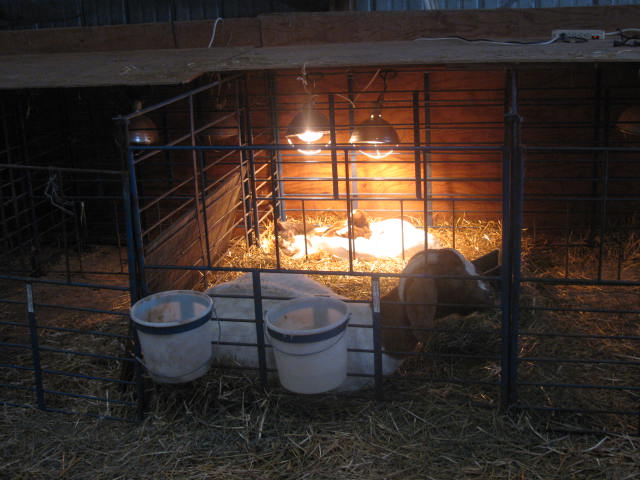Kidding Season is here! - 1/7/2011
by Carole Pontious on 10/31/13
Kidding season can be one of the most exciting yet stressful times for us goat breeders. Often times the bulk of our kidding season in the Midwest occurs during the harsh winters. Preparation, then, is the biggest key to a successful kidding season. This starts well before kidding season and actually starts at breeding time.
At White Oak Farm, we keep a marking harness on the breeding bucks so that the buck will mark the doe when she is bred. We then record this information so we know when to expect her to kid. Does are maintained on pasture, free choice hay, water, and mineral until two months prior to kidding.
Two months before kidding the does are placed in groups depending on the overall condition of the goats and fed accordingly (i.e. the heavy does are placed in one group and the thinner does are placed in another group). If you have ultrasound equipment, you could group does based on the number of fetuses the does are carrying. This can be a cost effective management tool for breeders who can feed does carrying singles less to avoid kidding complications of large single kids, while feeding does with twins or triplets more to supply them with additional nutrition to support their pregnancies.
It is very important that pregnant does are on a worming program to control parasites. This is critical to a successful kidding season. We have found that regularly submitting stool samples from our herd to our veterinarian for analysis and then worming based on those findings has benefited our farm the most in controlling parasites. Note that I did not say eradicate parasites as this is impossible. Controlling parasites, however, is our best defense.
Another key to a successful kidding season is hoof trimming. Surprised? Actually, it makes a lot of sense. Does with healthy feet will exercise more and be more fit. As a result, the does are less likely to have kidding complications. This, also, greatly reduces the chances of pregnancy toxemia because the does are not carrying excess weight (see our related article Pregnancy Toxemia in Boer Goats).
One month before the does are to kid, they get their final worming. In addition, we often give the does ox tetracycline injection subcutaneously. This is an antibiotic to reduce premature births and related fetal health issues. I have been told the dosage is 5 cc per 100 pounds, but we do not give over 5 cc. We give it under the skin, because we found it can burn the does if given intramuscularly.
A word of caution to breeders using ox tetracycline, we have received reports that some does could abort from the stress of the injection, which is why we never give more than 5cc. As another alternative, some goat breeders will mix a soluble powder form of tetracycline in the herd’s water supply. Check with your veterinarian to see if this practice should be implemented in your herd.
Final preparations include gathering your kidding supplies. We like to have goat nutri-drench, iodine, Bo-se, CD & T, colostrum, feeding tube, and bottles with nipples on site. When the does are close to kidding, we check on the does every four hours to assist if necessary. At birth, we dispense 2 pumps of the goat nutri-drench to the kids which gives them a source of energy between the time they are born to the time they nurse. This allows the kids a chance to be cleaned off, warmed up, and further develop their instinct to suckle.
We have individual 4 x 6 kidding pens for does and their offspring after they kid. A safety zone for the kids allows them to be under a heat lamp without the doe bothering the heat lamp or accidentally laying on her kids. This is extremely beneficial in the Midwest during the winter kidding. This also gives the new family a time to bond. One-half cc (1/2 cc) of Bo-Se is administered to the kids within 72 hours of birth. We give two cc of CD&T to the kids at two weeks of age and six weeks of age. The kids are given their shots subcutaneously.
While kidding season is a stressful time, we greet it with excitement. We have learned that preparation throughout the year using proper management practices is key to a successful kidding season. Best of luck!

A doe rests in a kidding pen while her kids sleep in the safety zone area under protected heat lamps.
